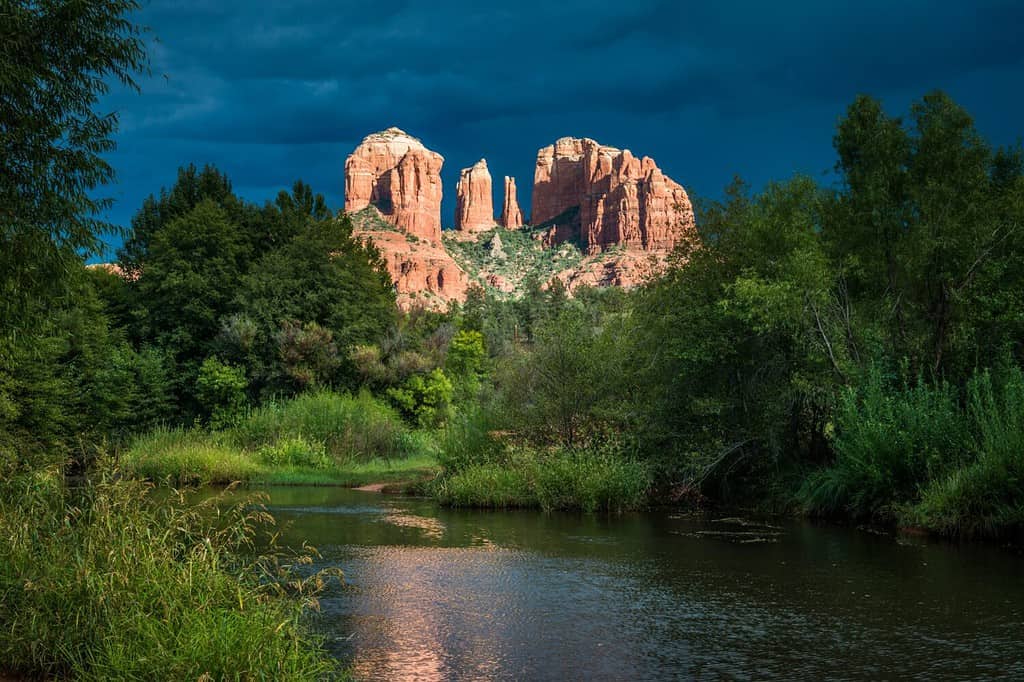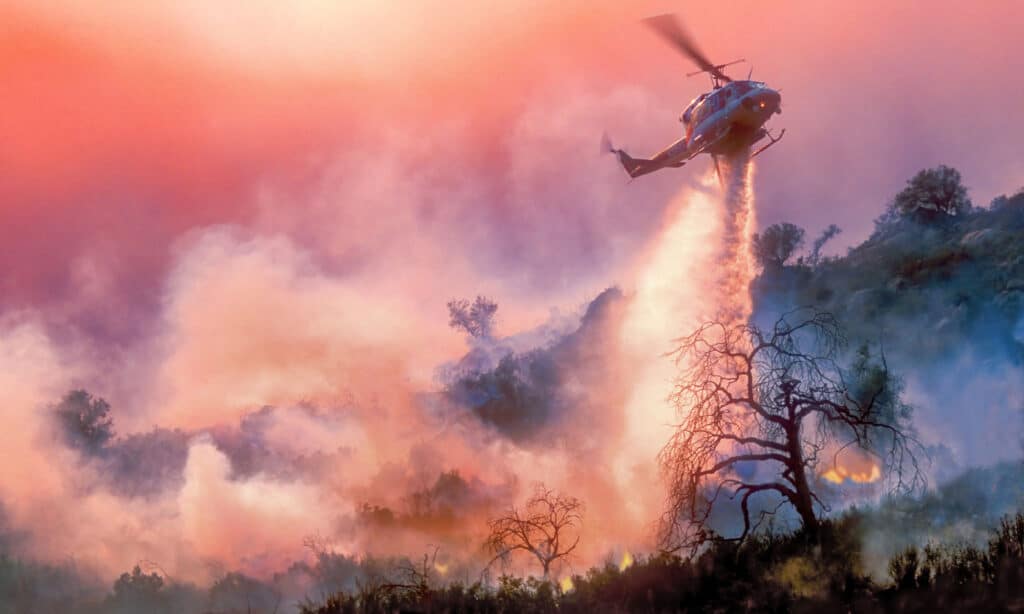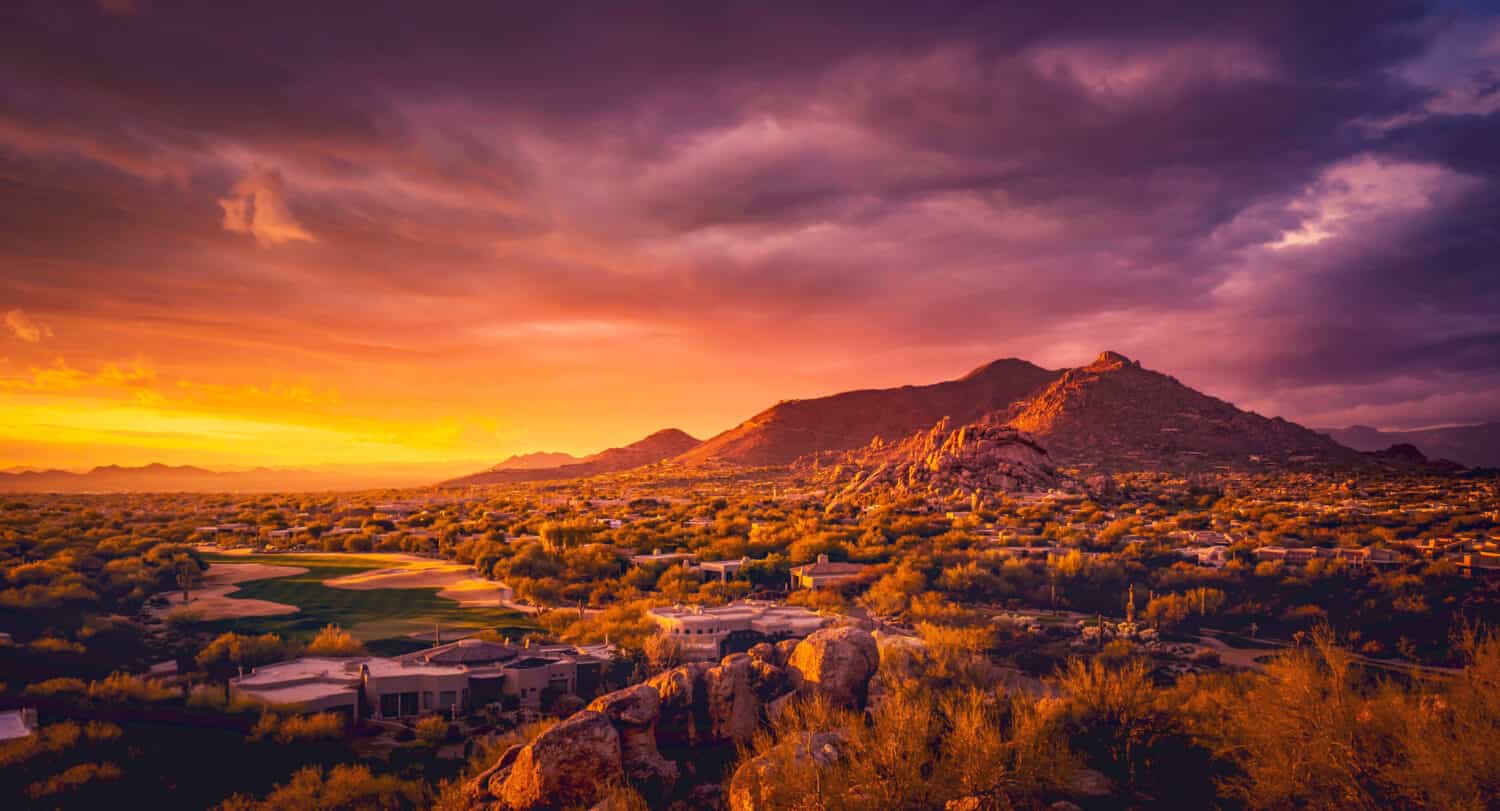When summer rolls around in the Grand Canyon State, things get seriously heated… and we’re not just talking about the temperature! Every year, Arizona braces itself for the wildfire frenzy that sweeps through its landscapes like a raging inferno. From the towering peaks of the Mogollon Rim to the cactus-studded desert plains, no corner of this arid paradise is safe from the flickering menace of wildfires.
Why does Arizona seem to attract wildfires like a moth to a flame? Well, it’s a wicked cocktail of dry, bone-cracking heat, parched vegetation, and gusty winds that can turn a simple spark into an unstoppable blaze faster than you can say “It’s just a dry heat”! And with climate change throwing its weight around, these fires are hungrier and more ferocious than ever before.
But luckily, visitors and locals alike can arm themselves with knowledge. Here’s everything you need to know about wildfire season in Arizona!
Wildfire Season in Arizona: When Does It Start?
This used to be a simple question with a simple answer. In the past, wildfire season in Arizona would start around late April or early May and continue well into the monsoon season. However, the start of wildfire season in Arizona nowadays is largely shaped by a confluence of environmental factors. In recent years, the impact of climate change has brought about notable changes to the timing and severity of wildfire season, necessitating a closer look at its implications.
Traditional Timing and Environmental Dynamics
Arizona’s wildfire season historically sets in from late April to June at the latest, coinciding with the transition from cooler months to warmer temperatures. This shift triggers a decline in humidity levels and an escalation in dryness across the landscape, creating conditions conducive to fire ignition and swift propagation.
Climate Change’s Role
Climate change has introduced shifts in temperature patterns and precipitation levels, influencing the initiation of wildfire season. With rising temperatures and altered precipitation patterns, Arizona experiences extended periods of dryness, advancing the onset of wildfire season. Warmer temperatures lead to faster evaporation of moisture from vegetation, rendering it more susceptible to ignition. These changes have accelerated the timeframe for wildfire activity, intensifying the challenge of wildfire management.
Amplified Drought Conditions
Climate change-induced drought exacerbates the arid conditions that set the stage for wildfires. Prolonged periods of insufficient rainfall desiccate vegetation, increasing its flammability. The extended duration of drought conditions further shortens the window for fire prevention efforts, placing additional pressure on firefighting resources.
Human Activities and Climate Feedback
Human activities, in combination with changing climate patterns, amplify the risk. Elevated temperatures can lead to more lightning strikes, a natural fire ignition source, while human-related actions continue to contribute to accidental ignitions. Furthermore, the shorter timeframe between ignition and peak fire behavior due to climate shifts poses challenges for efficient firefighting responses.
When is the Risk at the Highest?
There is no exact specific time when wildfires in Arizona are considered the most dangerous. The peak risk for dangerous wildfires in Arizona occurs during specific conditions that amplify the potential for ignition and rapid spread. The highest risk period is usually around June and July when a combination of factors converges to create a volatile environment.
To start, weather plays a pivotal role. During the start of wildfire season, the state experiences a transition from cooler months to warmer temperatures. This temperature shift leads to reduced humidity levels and drier conditions, which, when combined with strong winds, intensify the likelihood of fire ignition and expansion.
Also, the dryness of vegetation becomes a significant contributor to the heightened risk. Native grasses, shrubs, and trees lose moisture content as the dry summer progresses, making them more susceptible to catching fire. This “fuel drying” process significantly raises the flammability of the landscape.
Also, the presence of lightning storms further elevates the danger. Lightning strikes, prevalent in Arizona’s summer monsoon season, can trigger fires in areas with dry vegetation. These natural ignitions, combined with the arid conditions, pose serious challenges for fire management.
Human activities also contribute to the peak risk of dangerous wildfires. Accidental causes like discarded cigarette butts, unattended campfires, or equipment sparks can swiftly ignite fires in dry landscapes. Illegal activities, like using fireworks in fire-prone zones, exacerbate the situation.
What Areas of Arizona Are at the Highest Risk?
During wildfire season in Arizona, certain areas are particularly prone to high fire risks due to a combination of factors. These factors include the density of vegetation, proximity to wildlands, climate conditions, and wind patterns.
One such area at heightened risk is the Coconino National Forest. With extensive pine forests and dry conditions, this region is susceptible to fast-spreading fires. Communities like Flagstaff, situated near the forest, need to remain vigilant and prepared during this time to minimize potential damages.
Tonto National Forest is another high-risk zone. Its diverse landscape, including both desert and forested areas, creates a unique challenge. The dry vegetation and human activities in this region contribute to an elevated fire danger.
Gila County also faces considerable risk during wildfire season. The county’s extensive forests and grasslands increase the vulnerability to wildfires. The rugged terrain can hinder firefighting efforts, underscoring the importance of early prevention and mitigation measures.
In Santa Cruz County, the combination of low rainfall and gusty winds elevates the risk of wildfires. Communities like Nogales need to prioritize fire safety measures to protect lives and properties.
These high-risk areas demand heightened attention and preparedness during wildfire season. Local authorities, residents, and fire management agencies play a vital role in implementing preventative measures and fire-safe practices to minimize the potential impact of wildfires on communities and natural resources.

Coconino National Forest is at the greatest risk of destruction during wildfire season.
©Wirestock Creators/Shutterstock.com
Are Wildfires Dangerous in Arizona?
Wildfires in Arizona can indeed be very dangerous due to a combination of environmental conditions and human factors. The state’s arid climate, with its dry vegetation and periods of low humidity, creates an environment where fires can ignite and spread rapidly. As a result, when certain conditions align, wildfires have the potential to cause significant damage.
One of the key factors contributing to the danger of wildfires in Arizona is the state’s vegetation. The dry grasses, shrubs, and trees that cover the landscape serve as ready fuel for fires. When these plants lose moisture, they become more flammable, making it easier for fires to start and grow in intensity.
Also, the combination of high temperatures and strong winds during certain times of the year exacerbates the danger. The gusty winds can carry embers over long distances, allowing fires to jump containment lines and spread quickly to new areas. This dynamic, known as “fire spotting,” can make wildfires difficult to control and contain.
As mentioned earlier, in recent years, the effects of climate change have intensified the danger of wildfires in Arizona. Rising temperatures, altered precipitation patterns, and prolonged drought conditions contribute to an extended and more intense wildfire season. These changes further heighten the risks associated with wildfires.
How to Prepare for Wildfire Season in Arizona
Wildfire season in Arizona presents challenges that require proactive preparation and vigilance. Whether you’re a visitor exploring the state’s natural beauty or a resident, understanding how to prepare for wildfire season is essential for safety and the protection of the environment.
Preparing for Wildfire Season as a Visitor
1. Stay Informed
Before your trip, keep an eye on fire conditions and alerts. Check official sources like the Arizona Department of Forestry and Fire Management for updates on current fire risks and restrictions.
2. Follow Fire Regulations
Respect fire bans and restrictions. Campfires, fireworks, and other potential ignition sources are often prohibited during high-risk periods.
3. Choose Safe Activities
Opt for activities in less fire-prone areas. When hiking or camping, select locations with lower vegetation density to reduce the risk of accidental fires.
4. Properly Dispose of Smoking Materials
If you smoke, dispose of cigarette butts responsibly in designated containers. Avoid smoking in areas with dry vegetation that could catch fire easily.
5. Be Prepared for Emergencies
Carry a basic emergency kit that includes water, snacks, a first aid kit, a flashlight, and a communication device to stay connected.
Preparing for Wildfire Season as a Local Resident
1. Create a Defensible Space
Clear flammable materials like dry leaves and bushes within a certain distance from your home. This defensible space acts as a buffer against encroaching fires.
2. Develop a Family Evacuation Plan
Create a detailed evacuation plan with multiple escape routes. Discuss this plan with your family and practice it to ensure everyone knows what to do.
3. Assemble an Emergency Kit
Put together an emergency kit with essentials such as medications, important documents, non-perishable food, water, and hygiene items.
4. Stay Connected with Neighbors
Establish strong communication with your neighbors to share important information, offer assistance, and collaborate during emergencies.
5. Maintain Home Safety
Regularly maintain your property by trimming trees, clearing gutters, and using fire-resistant materials for home improvements.

Wildfires can be extremely dangerous and cause evacuations and displacement in vulnerable areas.
©iStock.com/David Aughenbaugh
How to Prevent Wildfires in Arizona
Sometimes, wildfires are simply a product of nature. However, there are a few things residents and visitors can do to reduce the risk of wildfires in the state:
- Clearing Flammable Debris: Regularly clean up dry leaves, fallen branches, and other flammable materials from around your home and property. This helps create a buffer zone that can impede the spread of fires.
- Responsible Smoking: If you smoke, ensure that cigarette butts are completely extinguished before disposal. Use designated containers for discarding them and avoid smoking in areas with dry vegetation.
- Safe Campfire Practices: When enjoying campfires, use designated fire rings or pits. Keep the fire manageable in size and have water or a shovel nearby to extinguish it properly before leaving.
- Cautious Equipment Usage: Use tools like lawnmowers and chainsaws with caution, particularly on windy days. The sparks generated from these tools can ignite dry grass and vegetation.
- Reporting Suspicious Activity: If you witness any suspicious behavior or signs of fire, report them immediately to local authorities. Quick reporting can prevent small incidents from escalating into major wildfires.
- Following Fire Bans: Pay attention to fire bans and restrictions imposed by authorities, especially during periods of high fire risk. Adhering to these measures helps prevent accidental ignitions.
- Educating the Community: Spread awareness about fire safety in your community. Inform others about responsible actions they can take to minimize the risk of wildfires.
Preparation and awareness are key to navigating wildfire season in Arizona, whether you’re a visitor or a resident. Staying informed, respecting fire regulations, and taking proactive measures to reduce fire risks can significantly contribute to the safety of individuals, communities, and the environment.
By working together to prevent wildfires and being prepared for emergencies, we can minimize the impact of these natural hazards and ensure a safer Arizona for everyone!
Thank you for reading! Have some feedback for us? Contact the AZ Animals editorial team.








